Mapping the Different Planktonic Groups at One of the Egyptian Bays along Mediterranean Coast- Juniper Publishers
Juniper Publishers- Journal of Oceanography
Abstract
The abundance and community composition of zooplankton is spatially and temporally variable so it requires sampling over space and time. Quantitative assessment of biomass, community composition, and abundance is sensitive for sampling methodology, including the location and seasonal timing of sampling, as well as mesh size and gear type. Therefore, repeated and consistent sampling is essential to determine the changes in zooplankton distribution, abundance, community composition and seasonal timing at time scales that have impacts on higher trophic levels. In the present study, El-Mex Bay is highly diversified (204 forms) but low standing crop (annual average 8935 organisms/m3). Using GIS and the other mapping applications give an easy and clear image about the distribution of aquatic fauna especially microscopic forms which help in understanding the dynamic of biological ecosystem.
Introduction
Zooplankton species are important lower trophic level members of marine ecosystem. They are a good indicator of ecosystem status since their populations respond relatively rapid to environmental variability and they are usually not fished [1].
In aquatic environment zooplankton is considered as one of the most important biotic components, particularly in the pelagic habitat. Zooplankton play a key role in the pelagic food web by controlling phytoplankton production and shaping pelagic ecosystem. In addition it has a critical role as a food source for larval and juvenile fish and consequently the dynamics of its populations have a great influence on recruitment to fish stocks. Such intermediate role of zooplankton makes it as a regulator of the biological productivity in the pelagic habitat, since it has a detrimental effect on phytoplankton by grazing and beneficial effect to the water fertility through nutrient recycling [2]. Zooplankton community demonstrates variable structure in the different aquatic habitats, relative to differences in the ecological conditions. Shallow marine coastal areas present an interesting subject of biological studies because of their productivity and the diversity of organisms which occur there [3]. Coastal marine areas are ecologically and economically important and of social interest [4]. They are extremely variable systems, where changes in the water circulation patterns and fluctuations of land influences (e.g. rivers, sewage flow) induce high temporal variability on scales ranging from hours to seasons. This variability may be reflected the dynamics of the populations, particularly planktonic ones, thriving in coastal systems and can hide the underlying seasonal patterns of organisms' abundance and biomass [4].
A fundamental challenge in Earth System science is the response of the marine ecosystem to changes in climatic forcing. In particular how will it affect ecosystem functioning and the sustainability of bio-resources. Datasets which allow us to map the distribution of marine biota are sparse. Satellite remote sensing can provide detailed information on a large scale for several bio-physical parameters, such as temperature and chlorophyll [5]. The challenge is to combine satellite data with the sparse in-situ datasets to generate distributions of higher trophic levels. To monitor the aquatic ecosystem and integrated of water, zooplankton has been recently used as bioindicator [6-12].
Abo-Taleb [13], Abdel Aziz et al. [14], Abo-Taleb et al. [12] they were found that fluctuation in the domination of copepods rotifers, Chromista and Protozoa resulted from the unstable environmental conditions of the bays and estuaries along the Egyptian Mediterranean coast. In the Egyptian part of the Mediterranean Sea, Zooplankton has attracted more attention particularly in the neritic waters. The first study has been conducted by [15]. Steuer [16,17] as preliminary reports on plankton hauls collected off Alexandria and Rosetta Coasts. Later one more detailed and comprehensive studies were carried out on zooplankton in different parts of the Egyptian Mediterranean waters. Some of these studies concern with the total zooplankton community off Alexandria Coast and Nile Delta Region Dowidar [18] studied the distribution and ecology of both phytoplankton and zooplankton in Alexandria region. El- Maghraby & Halim [19] investigated quantitatively and qualitatively the phytoplankton and zooplankton off the Eastern Harbor. Halim et al. [20] gave brief notes on the distribution of plankton organisms off the Egyptian Mediterranean Coast during the last normal Nile flood of 1964. Guerguess [21] and Dowidar & El- Maghraby [22], studied the distribution and ecology of the neritic zooplankton of the area surrounding Alexandria with special reference to Copepoda. Hendy [23] and El Raey et al.[24] , assess quantitatively the vulnerability to sea level rise of El Mex Bay and determine areas at risk of flooding and erosion.
El-Mex Bay has attracted little attention for the biological studies, although it lies under stress of huge and different types of waters. So, it is necessary to study zooplankton community in the bay. Hence, the present study is designed to study the dynamics of zooplankton community at El- Mex Bay, Using GIS (ARCMAP 10) to produce maps illustrating plankton abundance and diversity.
Material and Methods
Study area
El- Mex Bay is located west of Alexandria City, at longitude 29° 45' and 29° 54' E and latitude 31° 07' and 31° 15' N, It extends for about 15Km from Agami headland to the west to the Western Harbor to the east. The bay has a mean depth of 10m. Its surface area is about 19.4Km2, and its volume 190.3 x 106m3[25] . The shoreline of El- Mex Bay is rocky with narrow sandy beaches. It receives a heavy load of wastewater (7*109 m3/year) both directly from industrial outfalls (El- Umoum Drain) and indirectly from Lake Mariut via El- Mex Pumping Station [26]. El- Umoum Drain is mainly agricultural water. Lake Mariut receives also wastewater from the four sources in its eastern section, consisting of domestic, industrial and agricultural wastes, this liquid wastes discharged to the harbor via El- Mex Pumping Station.
Samples were collected seasonally during 5 seasons from autumn 2011 to autumn 2012 from eight stations. The stations were selected to cover all possible environmental changes of the study area. The locations of the sampling stations are shown in (Figure 1).
Zooplankton samples
Zooplankton samples were collected at each station by standard plankton net (No. 25) of 55μm mesh size which lowered vertically till near the bottom then pushed up to the water surface. The zooplankton organisms which retained in the net were then transferred into smaU bottle and preserved in 5% neutralized formalin solution and the sample volume was then adjusted to 100ml. The samples were examined under a binocular research microscope. The identification was undertaken to species levels. For estimation of standing crop, sub samples of 5ml were transferred to a counting chamber (Bogorov chamber) using a plunger pipette this operation performed three times and the average of the three counts was taken, and the standing crop was calculated and estimated as organisms per cubic meter according to the following formula [27]
N= (n * v) / (V * 5)
V= πr2.d
Where;
N: Total number of zooplankton per cubic meter.
n: Average number of zooplankton in 5ml of the sample.
v: Volume of concentrated sample (100ml).
V: Volume of total water filtered (m3).
d: Length of the traction by the net.
Identification of the different species of zooplankton species was carried out according to Sars [28,29] (Copepoda), Rose [30] (Mediterranean copepods), Tregouboff & Rose [31] (Mediterranean plankton), Pontin [32] (Freshwater plankton), Guerguess [33], Hutchinson [34] (Plankton as a general), Marshall [35], Bick [36], Paulmier [37], Jorgensen [38] (Protozoa), Gurney [39-41] and Hardig & Smith [42] (freshwater Copepoda), Wilson & Yeatman [43], Edmondson [44], Gurney [45] (Copepoda and Cladocera), Berzins [46], Berzins & Pejler [47] (Rotifera), Sars [48] (Ostracoda), Sars [49] (Entomostraca) and using WORMS database [50].
Data analysis
The remotely sensed satellite imagery (LAND SAT 7) was found to be the most appropriate one for this study, as with its regional coverage, all necessary map features were obviously clear and interpreted. A raster depending software was used for the purpose of digitizing the map features. ARC-GIS 10 and Envi software was used for this purpose for its high digitization capabilities, also in finalizing and visualizing data. The analysis and interpretation of different zooplankton groups was done by ARC-GIS 10.
Diversity index was estimated according to Shannon & Weaver [51] as follows:
H = - Σ Pi ln Pi
Where;
Pi = n/N
Pi: is the proportion of a species number (n) to the total number of zooplankton (N).
Results
Diversity of zooplankton groups in the bay
Zooplankton community in the El-Mex Bay was represented by 204 species belonging to 12 groups. Protozoa was the most diversified group in the bay 69 species, followed by Copepoda which represented by 50 species. Rotifera ranked the third diversified group in the bay represented by 38 species, Chordata represented by 9 forms while, Cnidaria, Mollusca and other Arthropoda were represented by 6 forms for each one of them, Cypredina, Cladocera and Annelida were represented by 12 forms, four to every group. Two cirripedian forms and two Chaetognathans were recorded, two Radiolaria, one Pteropoda and Porifera residues (Figure 2).

The number of species varied temporary where the highest number of species were recorded during winter (151 species), decreased during spring to reach 123 species and still decreased during summer and autumn 2012 to reach (114 and 113 species) respectively. Number of species differed from one station to another with its maximum at station I and VI (130 and 131 species respectively) reaches 126 species at station III and ranged from 105 to 116 species at the other stations, with the most diversity at station IV (100 species) as recorded in (Table 1) .
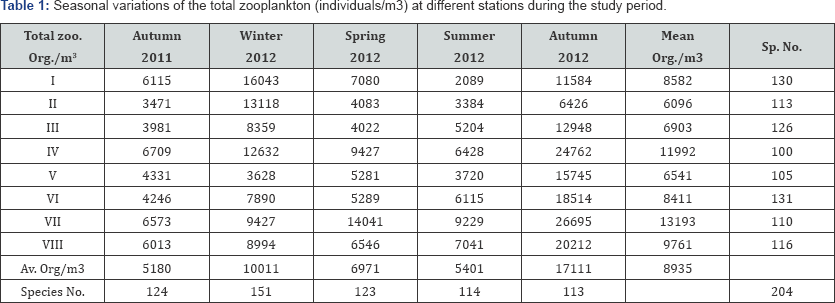
Relative contribution (%) of different groups
As shown in Table 2, Copepoda was the most important group, contributing 55% of the total zooplankton. Protozoa occupied the 2nd order of abundance forming 15.6% of the total zooplankton. Rotifera formed 11.7% of the total zooplankton. Other groups were frequently encountered such as Larvacea, Chaetognatha, Cladocera, Cirripedia, Ostracoda, Chordata, Mollusca, Annelida, Nematoda and Cnidaria.
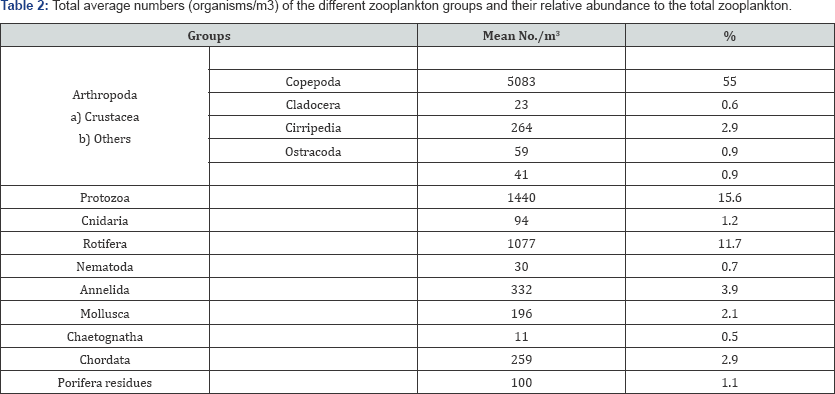
Dynamics of zooplankton groups in the bay (Zooplankton groups distributions)
Zooplankton communities showed wide seasonal variations at El- Mex Bay, the following data described these fluctuations (Figure 3-7).
Copepoda: Appeared as the predominant component of zooplankton in El- Mex Bay. The adult copepods formed 63% of total copepod counts with an average of 3218 individuals/m3 while, the rest 37% were represented by copepodite stages and nauplii with an average of 1866 individuals/m3. The maximum density was recorded during autumn 2011 and gradually decreased to their minimum value during spring 2012.
Protozoa: Ranked the 2nd dominant group in the bay with annual average of 1440 organisms/m3. Generally, winter and spring seasons showed maximum densities (average of 2272 and 2045 individuals/m3), while minimum average counts were recorded at the beginning of the study during autumn 2011. Their counts ranged between maximum of 5860 individuals/m3 at station VII during spring and minimum of 212 individuals/m3 at station V during autumn 2011.
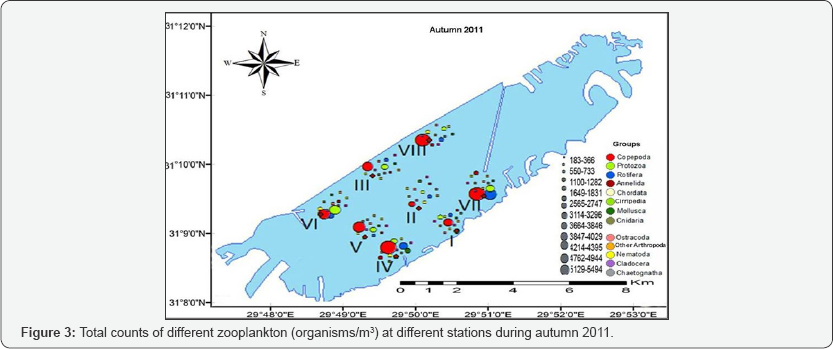


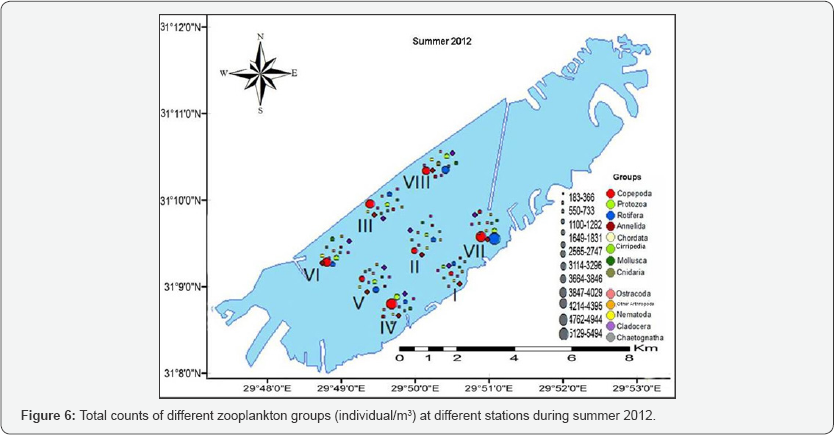
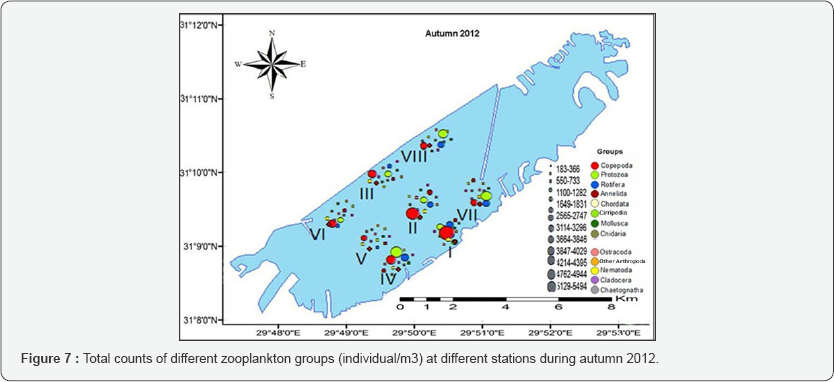
Rotifera: Ranked the 3rd group and recorded annual average 1077 individuals/m3. 38 rotifer species were identified under 16 genera within 12 families, 3 orders and one class. The maximum counts were recorded at station VII (4161 individuals/m3) during autumn 2012 and minimum of 170 individuals/m3 at station V during autumn 2011. The highest rotifer average was recorded at station VII (2508 individuals/m3), while stations III and V showed minimum average counts of rotifers (596 and 558 individuals/m3)
Annelida: Ranked as the 4th dominant group at the El- Mex Bay during the study period, they constituted 3.9% of the total zooplankton groups with average total counts of 332 individuals/m3. Their minimum values were recorded during autumn 2011 (188 individuals/m3) and flourished during winter 2012 with a maximum of 556 individuals/m3. Annelids were represented by some adult polychaete species, polychaete larvae and different stages of Spionid larvae included several stages of trochophore larvae (late trochophore, early trochophore, and mid. trochophore). According to spatial distribution they recorded their maximum values (1137 individuals/m3) at station II during winter 2012 and minimum of 42 individuals/ m3 at station V during autumn 2011(Table 3).

Chordata: Constituted 2.9% of the total zooplankton groups and occupied the 5th rank in the bay after annelids with average numbers were 259 individuals/m3. During winter and spring 2012 chordates flourished and recorded their maximum average counts (424 and 329 individuals/m3) respectively while it showed lower values during summer (105 individuals/m3). They recorded the maximum density (1035 individuals/m3) at station I during winter 2012, while it was absent at station IV during autumn 2011 and at station VII during summer 2012. Chordata in the El-Mex Bay were represented by Euchordata and Urochordata. Euchordata expressed as fish eggs and larvae. While Urochordata represented by two classes; Appendicularia and Ascidiacea, the first class included five species were Folia sp., Oikopleura dioica, O. parva, O. fusiformis and O. longicauda. On the other hand the second class was represented by Tadpole larvae of tunicate (Phallusia mammillata and Ciona intestinalis), this class was recorded by small counts (Table 3).
Cirripedia: Ranked the 6th order of abundant and was represented by nauplii larvae and cypris larvae of cirripeds. They formed collectively 2.9% with total average counts 264 organisms/m3. It was recorded throughout all the year except at stations IV and V during summer 2012. They recorded their maximum counts (589 individuals/m3) during autumn 2012 and decreased to 77 individuals/m3 during summer 2012. Cirriped larvae were the dominant Cirripeda (Table 3).
Mollusca: Ranked the 7th order of abundant with total average of 196 individuals/m3 during the investigated period; they constituted about 2.1% to total zooplankton groups. Mollusca were recorded in all the study seasons, their maximum values were during summer and autumn 2012 (268 and 285 individuals/m3), while they became the lowest (133 individuals/ m3) during spring. Mollusca in the bay were represented by gastropods, pteropods and the lamellibranch veliger (Table 3).
Cnidaria: was represented by 1.2% of total zooplankton groups with total average was 94 individuals/m3. Generally, Cnidaria recorded their maximum average values (165 individuals/m3) during spring; on the other hand the minimum values were recorded during the two autumn seasons (42 individuals/m3). Cnidaria recorded their maximum values at the stations which located at the sea side (stations III with average 95 individuals/m3 and station VIII with average 125 individuals/ m3) and total average of 140 individuals/m3 at station IV due to the relatively high salinity values at this station (Table 3).
stracoda: represented 0.9% of total zooplankton with average was 59 individuals/m3. Their maximum densities were recorded during autumn 2011 and winter (74 and 77 individuals/m3), while minimum densities (21 individuals/ m3) were recorded during summer 2012. Ostracoda at El-Mex Bay dominated by Cyclocypris sp., Cypridina mediterrianea, Cytheridea punctillata and Xestoleberis depressa (Table 3).
Other arthropoda: In this study was represented by Insect species and their larvae, water mites, Mysis relicta, Gammarus marinus and Zoea of Decapoda. They formed collectively 0.9% of total groups with average numbers were 41 individuals/m3. During winter and spring seasons they flourished to be 87 and 48 individuals/m3 respectively, while their minimum values were recorded during the two autumn seasons (6 and 25 individuals/ m3 respectively). Through the whole study period these forms were absent at station V. While the maximum values (average 74 individuals/m3) were recorded at station VII and station IV (average of 54 individuals/m3).
Nematoda: Were represented by free living nematodes which formed only 0.7% of the total zooplankton groups, with total average 30 individuals/m3. They recorded their maximum density during autumn 2011 (44 individuals/m3) and minimum of 11 individuals/m3 during autumn 2012. According to spatial distribution, nematodes were completely absent from station IV all the study period. On the other hand they were dominated at stations I with total average of 58 organisms/m3 and decreased to minimum at station V (9 individuals/m3) (Table 3).
Cladocera: Was dominated by Evadne spinifera, Podon polyphemoides and P. leuckarti and Moina micrura. Cladocera represented by 0.6% of total zooplankton with total average number were 23 individuals/m3. Cladocera flourished during two seasons, winter and spring (26 and 63 individuals/m3) but their minimum value (5 individuals/m3) was recorded during summer. They were absent at station II. On the other hand they recorded their maximum average counts at stations III (35 individuals/m3) at the first section, VII and VIII (34 and 36 organisms/m3 respectively) which located at the right side of El Umoum Drain inlet (Table 3).
Chaetognatha: In the El- Mex Bay constituted 0.5% and averaged 11 individuals/m3. They disappeared from the bay during spring but recorded their maximum densities (average, 19 individuals/m3) during winter. According to spatial distribution Cheatognatha was absent from stations I, V and VI through the whole study period, while they recorded their maximum values (average, 28 individuals/m3) at stations III and VIII during winter and station IV during autumn 2012 (Table 3).
Diversity index
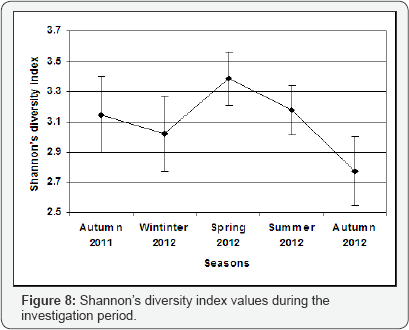

Shannon’s diversity index of the zooplankton assemblages fluctuated between a minimum of 2.77±0.23 during autumn 2012 to maximum of 3.39±0.18 during spring (Figure 8) Station VII showed maximum diversity index (3.63) during spring season and also the minimum diversity index (2.48) during autumn 2012. According to spatial distributions the maximum diversity index was recorded for stations II and VI where there diversity index values were 3.25±0.28 and 3.22±0.18 respectively (Figure 9).
Discussion
The observed spatial and temporal variations of the zooplankton abundance might be traced to the effect of El- Umoum Drain discharge into El- Mex Bay. With increasing phytoplankton biomass, the abundance of phytoplankton cause herbivorous zooplankton species to increase [52]. Due to pollution and eutrophication the copepod Acartia clausi was favored, while rare species became extinct [53]. Zhenbin et al. [54] reported that zooplankton community structure changed from eutrophic-indicator genera (Brachionus, Polyarthra and Keratella) to genera more characteristic of oligotrophic conditions (Tintinnopsis and Acanthocyclops). Li et al. [55] also found that the dominant species Brachionus spp. and Keratella spp. were replaced by Tintinnopsis spp. in Xihu Lake.
Hussein [56] recorded 121 zooplankton species, while El- Sherif [57] found that zooplankton community in El- Mex Bay was represented by 130 taxa. The present study revealed that zooplankton of El-Mex Bay is highly diversified (204 forms) with low standing crop (annual average 8935 organisms/m3). The species composition of zooplankton community reflects clearly the effect of the land based effluents, whereas the high salinity stations were comparatively lesser diversified than the low salinity stations. On the other hand, effect of El-Umoum Drain and El-Mex Pump Station resulted also in clear temporal variation of species richness at each station relative to variations in values of discharged water.
The high zooplankton diversity during the present study is attributed to the intrusion of the freshwater ciliates and rotifers. Day et al. [58] reported that most estuarine zooplankton organisms have evolved to broad physiological tolerance in order to ensure their survival into unstable environmental conditions and consequently results in high species composition. The temporal distribution of zooplankton composition demonstrated the highest diversified community (151 species) appeared in winter and the lowest (113 species) in autumn 2012, these variations could be attributed to temporal changes in the number of freshwater species enter into the bay through the discharged waste waters also due to the environmental variables like temperature , salinity, nutrients and phytoplankton biomass. These observations are in agreement with Morques et al. [59,60].
The temporal variations of diversity provide useful information on succession of community structure and it may be used as an index for assessing the degree of environmental stress [61]. Day et al. [58] whereas the pollution causes the loss of some sensitive species and led to the occurrence of few of the most tolerant species in great numbers.
The temporal zooplankton abundance showed peaks during winter and autumn 2012. The high water dynamics in these two seasons may play clear role in temporal variations of zooplankton abundance. This contradicts with the observation in other areas, where temperature was the essential element in the seasonal dynamics of zooplankton [62].
The copepods were the dominant component of zooplankton in El-Mex Bay. This observation is agreed with other studies on the marine ecosystem [63-68]. El- Sherif [57] found that Copepoda was represented in the study area by 22 species, only one of them (Acanthocyclops americanus) belongs to the freshwater forms. Other recorded species, Acartia clausi, A. latisetosa, Paracalanus parvus, Oithona nana and Euterpina acutifrons are eurythermal and euryhaline species. They are common at the near shore waters west of Alexandria [56,69].
In El- Mex Bay, the freshwater rotifers are more diversified and the predominant zooplankton component in the water mass is directly stressed by El- Umoum Drain. Rotifers are usually known as the major zooplankton component in the freshwater habitate [70]. The high species number of rotifers at the low salinity stations compared to those at stations (I and IV) indicates the role of discharged freshwater. The rotifers' diversity in El- Mex Bay were rich (38 species), perhaps due to the effect of the mixture of freshwater and marine species and the high trophic level of the system. This agreed with [53] and [9] whom mentioned that the bay subjected to high trophic conditions. The majority of species in this study were euryhaline forms (21 species) and the rest species were freshwater forms (17 species). Throughout the present investigation, the percentage of genus Synchaeta was 51.3% of the total rotifer abundance followed by Brachionus with 19.1% and Keratella 4.5 % [9].
[71] stated that rotifer was the leading group at the mixed land drainage water type constituted 85.75 % of the total zooplankton community in the bay. Protozoa occupied the 2nd order of abundance among zooplankton groups in El-Mex Bay contribution 15.6 % of the total zooplankton counts (averaged 1440 organisms/m3), predominated by ciliates. Protozoa are characterized by many specific structural and functional features, present an important ecological assemblage in aquatic ecosystem and play a crucial role in the function of microbial food webs in addition to their role as indicators of water quality [72]. Protozoa community in El- Mex Bay is pronounced affected by the dispersion pattern of discharged waters. Higher values were particularly observed during winter 2012 (2272 organisms/m3) while autumn 2011 displayed lower densities (519 organisms/m3). Protozoa reached the maximum density at station VII during spring 2012 (5860 organisms/m3) due to the predominance of Centropyxis aculeate, Difflugia oblonga, Favella azorica, Tintinnopsis beroidea, T. campanula, T. cylindrical, and T. lobiancoi.
El- Mex Bay has the highest tintinnid densities during the study period which was dominated by Tintinnopsis beroidea, this agreed with [73] while [57] stated that Protozoa was the highly diversified group in the Western part of Alexandria. It was represented by 63 species (48.46% to the total number of the recorded species). Out of them, 40 tintinnid species, 11 Foraminifera species and 12 species of fresh water ciliates. All tintinnid species are marine forms while some of Foraminifera species are belonging to freshwater forms. Zakaria et al. [71] stated that Protozoa was the second important group after rotifers in the bay. Pteropoda appeared very rare in El-Mex Bay due to the acidification of the bay during sometimes, absence of this group is considerable evidence of the high acidity of any water body, This agree with [74]. Pteropods are the most sensitive Planktonic group because their shell is composed of aragonite, which will be subject to increased dissolution under more acidic conditions. Pteropods would not be able to adapt quickly enough to live in under saturated conditions. Pteropods, with their aragonite shells, are highly vulnerable, while, foraminifera and some crustaceans, with their calcite shells and liths, are less vulnerable. Pteropods are likely to decline and may eventually disappear in response to ocean acidification [75].
Nematods represented by 0.7 % of the total zooplankton with an average of 65 organisms/m3. Nemeth-Katona [76] considered that the presence of nematodes is an indication of the final stage of contamination with sewage, the ultimate putrefaction of water: hydrogen sulphide indicator. Cladocera are considered to be important in the economy of the area because of their relation to pelagic fisheries and are believed to play an important role in the phosphorus regenerate [77]. during the study period Cladocera represented by 0.6% of the total zooplankton with total average number were 23 organisms/ m3 dominated by Evadne spinifera, Podon polyphemoides and P leuckarti and Moina micrura flourished during winter and spring, their minimum values during summer, occurred intermittently at the sampled stations. Although salinity seems to impact the spatial distribution of Cladocera at El-Mex Bay the freshwater species Moina micrura was recorded at some sampled stations indication it is tolerance of wide salinity. Moina micrura is a common species in eutrophic water and can be indicator of eutrophication [78]. Food concentration may affect growth and reproduction of cladocerans [79].
Cirripedia contributed 2.9 % of the total zooplankton (averaged 264 organisms/m3), exhibited comparatively high abundance at high salinity, and disappeared at low salinity stations. This showed by significant correlation between cirripeds and salinity. Jeffries [80] reported that the overabundance phytoplankton as food is associated factors may have been responsible for delay reproduction of adult cirripeds. Polychaetes and larvae were found during the study period with a percentage of 3.9 % and covered the whole area at wide salinity range. These larvae are described as estuarine zooplankton component, being restricted to low salinities and an aerobic conditions or high pollution levels [81] and they play crucial role in meroplankton in the Egyptian Mediterranean coastal water [82].
The presence of freshwater species (Copepoda, Cladocera, Protozoa and so on) in marine coastal areas are considered a biomarkers on the presence of fresh water discharge into these areas, and according to types of this species can determine the source of water discharged neither rivers, lakes, drainage or sewage Froneman [83].
Conclusion
From the obtained results it concluded that El-Umoum Drain discharge, maritime activities and shipping movements in the study area were reflected on the hydrographic conditions and the dynamics of zooplankton community in the El-Mex Bay. The zooplankton showed great numbers of freshwater species which considered as bioindicator to the huge amount of freshwater entering the bay, also the great numbers of rotifers and the presence of other forms like nematodes and some ciliated protozoa serve as bioindicators of pollution and declining water quality.
For more about Juniper Publishers please click on: https://twitter.com/Juniper_publish
For more about Oceanography & Fisheries please click on: https://juniperpublishers.com/ofoaj/index.php

Comments
Post a Comment